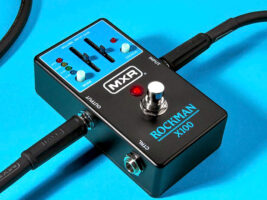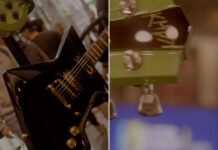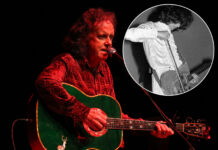
How the Rockman revolutionised guitar tone and changed recording forever
The techniques used for recording guitar haven’t changed that much over the years. Even though direct recording has been around for a long time, it’s only recently that going direct has become an acceptable option for guitar players. DI sounds were often harsh, brittle and thin-sounding, leading to most players preferring the trusty old method of mic’ing up a speaker cabinet when it came to recording their tones… but then the guitarist from Boston came along and changed things…
READ MORE: MXR Rockman X100 review – it’s the 80s in a box
Tom Scholz was the founder, guitar player and mastermind behind legendary 70s rockers Boston. But in addition to writing every bit of More Than A Feeling by himself, Scholz was also an MIT-trained engineer – a handy thing to have in your back pocket if the whole ‘write one of the most iconic rock songs of all time’ thing doesn’t work out.
Anyway, in 1982, Scholz designed a quirky little device for his electric guitar that could fit in your hand. It was no bigger than a normal DI box, or the new-at-the-time Sony Walkman portable headphone cassette player. But the tones you could get out of it were larger than life.
This is the story of the Rockman, the device that invented the concept of amp simulation.
Tom Scholz, 1994. Image: Karjean Levine/Getty Images
Enter Rockman
In truth, the Rockman was far from Scholz’s first guitar-related innovation. He had long used his electronic engineering background to enhance and improve the basement studio he’d created to record much of Boston’s early work.
As the glow of More Than A Feeling faded, he’d even created his own company to bring some of his innovations to life – Scholz Research & Development, Inc.
The first SRD product was another attempt to create a big sound without excessive volume – the Power Soak. The Power Soak was one of the first examples of what we would now call an attenuator. It sat between an amp’s speaker output and the speaker input on a cabinet, and with it, guitarists could drive their amps to get a saturated tube tone without deafening decibel levels.
It was his next innovation that would truly etch Scholz’s name into the history of guitar gear, however – the Rockman. The Rockman, Scholz claimed, could replace $10,000 worth of studio gear and fit in the palm of your hand.
This portable headphone amplifier included four built in amp simulations – two cleans, an overdrive and full distortion – plus effects like stereo chorus and chamber echo.
In an era before digital amp sims and good-sounding solid-state gear, the Rockman was a hugely impressive portable headphone amplifier… but guitar players and studio engineers were about to discover it could be so much more.
The MXR Rockman X100. Image: Press
Direct Line
This is because not too long after the Rockman debuted, guitarists and recording engineers began to realise that if this little box sounded great through a set of headphones, it might also sound great running straight into a desk.
And so it did – what was intended to be a simple headphone amp offered guitarists a signal direct to a recording console that was packed with crystal cleans, natural harmonics and mid-heavy drive tones. There was even a little onboard compression and analog stereo chorus to enhance the whole package.
The Rockman’s great headphone sounds were something of a revelation for both bedroom players and touring guitarists alike. The latter were especially taken with the ability to warm up practice or warm-up in silence, or record some ideas on the road. Scholz’s efforts were officially validated when he received a Rockman warranty card in the mail from none other than Jeff Beck!
Decades before Line 6’s POD brought compact, digital amp simulation to the masses, Scholz and the Rockman were effectively doing the same thing in an analogy form – it was in many ways the first compact amp modeller.
Breaking The Mould
The Rockman was an innovative piece of gear that offered some key features. It was one of the first devices with realistic solid-state amp simulation. One of the signatures of the circuit is built-in compression, which helps sustain the signal and limit the output from clipping. Chorus and echo effects are stereo, which widens the sound.
With it Scholz blazed the trail for the modern digital hardware and software we have today – even if he’s not a fan of the results. “Don’t get me started on the many shortcomings of digital sound,” says Scholz today.
Going Big
Realising that it could be used as both a recording and practice tool took a little while to catch on, but before long it was being used by big bands who were plugging in the Rockman and causing us to rethink how recorded guitar sound was made.
You can hear it on KISS’ Animalize, ZZ Top’s 1985 release Afterburner, and virtuoso shredder Joe Satriani’s hugely influential debut Surfing with the Alien.
But perhaps the most famous use case is on Def Leppard’s Hysteria – indeed much of the hype for the MXR Rockman pedal’s release has been about the ‘Hysteria in a box’ fun it produces.
The arena-ready sounds of the Rockman were perfect for the vibe the band and producer Mutt Lange were chasing, and it heavily influenced the album’s polished sound. What’s more, for an album that was legendarily tortured and troublesome to create, the Rockman at least mitigated a lot of studio headaches and saved time twisting amplifier controls and moving microphones.
Rock…men?
The Rockman was a smash then, and soon SRD started producing other guitar products based on the original’s innovation. The first of these were the Rockmodules. Released in 1986, these were half-rack mounted breakout boxes of individual circuits from the Rockman. They expanded on the original’s capabilities and features, offered greater flexibility, and easier integration into guitarists’ racks – the Rockman could now rock stadiums with ease.
Rockmodules cashed in on the growing rackmount trend and include the Sustainor and Distortion Generator amplifier simulators, Instrument EQ, Guitar Compressor, Smart Gate, Stereo Chorus, Echo, and Chorus/Delay. There were also the MIDI Octopus and Dual Remote Loop units, all with the efficacy of making it easier for guitarists to fit them into their rigs.
By the late 80s and early 90s digital effects were becoming increasingly popular, and analog gear was considered old tech – the original Rockman was discontinued in the early 90s. In 1995 Scholz Research & Development shut down and the Rockman brand was sold to Jim Dunlop. Scholz registered more than 30 patents over the course of his career, and most of the revenue was donated to charity.
Rockman Til You Dropman
Dunlop has continued to produce Rockman Guitar Ace and Metal Ace portable amps in the decades since the company acquired the rights – and they’ve continued to be popular practice tools even as digital amps have made practice amps more and more impressive and versatile.
Then, at NAMM 2025, MXR debuted a new pedal that revitalized the interest in the Rockman – the X100. A Rockman reborn in pedal form, the X100 offers the same stereo guitar sound, four familiar amp tones, and lush chorusing as the original, but in a form factor that can slot onto any board.
The post How the Rockman revolutionised guitar tone and changed recording forever appeared first on Guitar.com | All Things Guitar.
Source: www.guitar-bass.net











